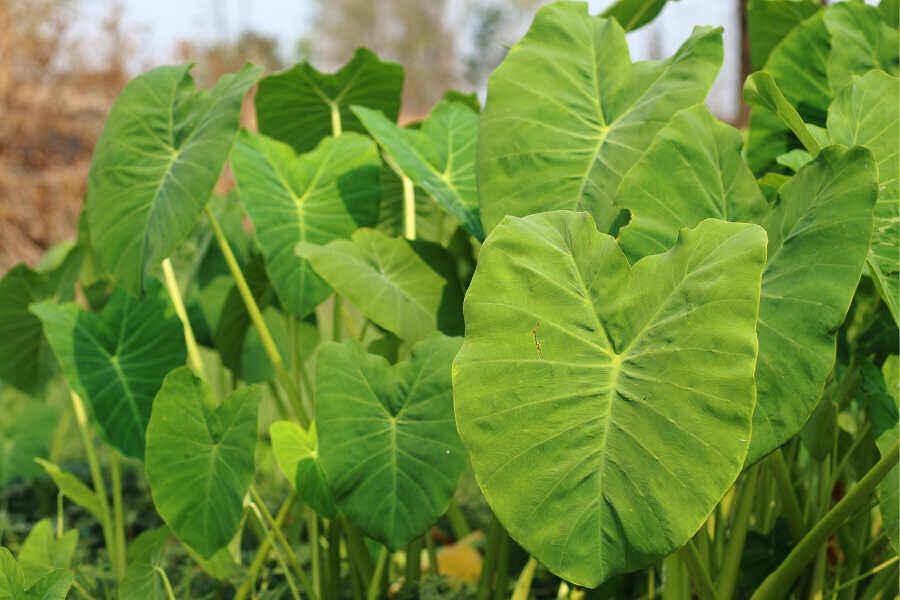Elephant ears are not only beautiful, but their large, showy leaves also make them quite tempting. You may have found yourself wondering if these plants are edible. Well, wonder no more! In this article, we’ll explore the world of edible elephant ears and provide you with everything you need to know.
Which Types of Elephant Ears Are Edible?

Colocasia
Colocasia plants, particularly the Colocasia esculenta species, are safe for consumption. These tropical plants offer over 25 edible varieties. They have underground parts composed of large central corms and numerous swollen lateral tubers. After peeling off the outer husk, you’ll find sweet and savory flesh inside. These tubers have been eaten safely by many cultures for hundreds of years. They are a popular staple in Southeast Asian cuisines, including Cambodia, China, Vietnam, and the Philippines. Colocasia plants take around two months to mature and can be used to make delicious dishes like Hawaiian poi.
Alocasia
Most Alocasia cultivars and varieties are not suitable for human consumption due to their high oxalic acid content. However, a few varieties have edible stems. The most popular among them is the Giant Taro (Alocasia macrorrhiza). Although it resembles taro, it has its own unique nutritional profile. The white parts of its edible stems and tubers can be cooked and consumed. Moreover, you can dry and grind the stem interiors into a powder for easy cooking and storage. Overall, Alocasia elephant ears are not as palatable as other varieties and require careful preparation.
Xanthosoma
Elephant ear plants from the Xanthosoma genus, native to South and Central America, have both edible and highly poisonous varieties. The Xanthosoma sagittifolium, also known as the arrowleaf elephant ear, is one of the most popular edible options. Its corms are starchy and serve as a vital staple food in tropical South America. The Xanthosoma caracu, or Yautía Blanca, is another edible variety known for its pinkish or yellow fleshy parts. Both the corms and leaves of these Xanthosoma plants must be cooked before consumption.
How Do You Consume Edible Elephant Ears?
Edible elephant ears offer various ways to tantalize your taste buds:
- Foliage can be used as greens: Boil the leaves for about 15 minutes in water with a little baking soda. Then, drain and rinse them before consumption.
- Tubers, roots, and corms can be consumed like a potato: Pound or grind them into a paste or powder. The popular dish poi, for instance, involves mixing fermented taro starch with water and cooking it into a delicious paste.
- Young tender shoots: Grow the corms in the dark to obtain tender shoots that taste like mushrooms. These shoots can be used in dishes such as the beloved stew known as calalou. Elephant ear leaves can also serve as wraps or serving vessels for steamed meats, cooked rice, and veggies.
Steps To Take Before Consuming Edible Elephant Ear
It’s crucial to remember that all raw elephant ears are toxic due to various alkaloids present, like oxalic acid or calcium oxalate crystals. Therefore, all edible parts of elephant ears, including the roots, leaves, and stems, should be cooked and not consumed raw. Cooking breaks down these alkaloids and renders the plant parts palatable. Consuming raw elephant ears can lead to irritation, burning sensations, and even stomach upsets.
What’s the Taste, Texture, or Flavor of the Edible Elephant Ear?
One advantage of edible elephant ears is that they retain their shape when cooked and absorb the flavors of herbs and spices. The leaves have a lush taste similar to spinach, while the tubers, roots, or corms offer a potato-like flavor and texture. Due to their high carbohydrate content, they are dense and starchy. Additionally, they have a mealy texture that allows for various cooking methods like grating, mashing, boiling, frying, or roasting.
In conclusion, elephant ears can indeed be a delicious addition to your culinary endeavors. As always, remember to cook them properly to ensure a safe and enjoyable dining experience. Happy cooking!
Sharing is caring!



